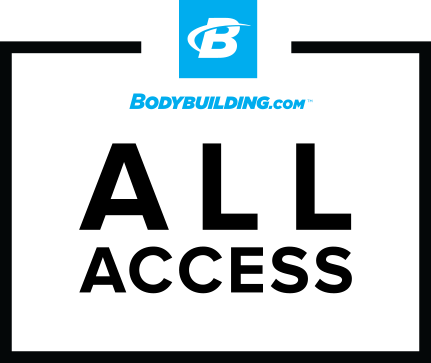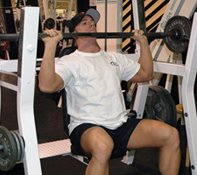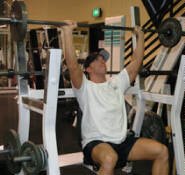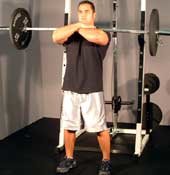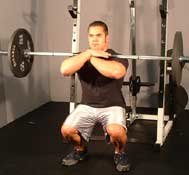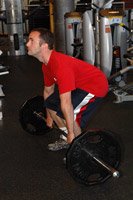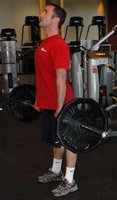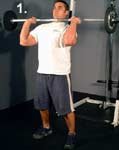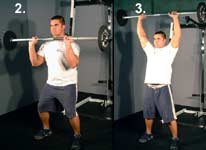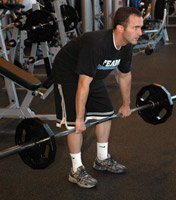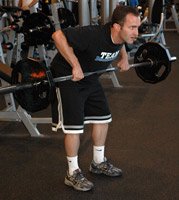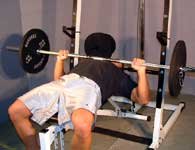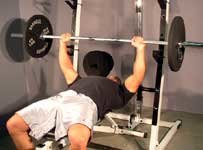Beginner's Guide To Program Design
The #1 problem I've found while consulting with novice lifters (and many experienced lifters for that matter) is that they don't know how to design an effective bodybuilding program.
The most common practice is to default to a body part split, typically resulting in a chest day, legs day, back day, arms and abs day, and calves and shoulders day. I suspect that a number of you are reading that and saying, "So? What's wrong with that?" Glad you asked.
1. Reinforcing Specific Movement Patterns:
The most important thing for a beginner to do is reinforce specific movement patterns. By using a body part split, each movement can be emphasized only once during any given week.
This reinforcement is referred to as motor learning, and results in significant strength gains in new movements (which most lifting movements are for beginners). Also, the emphasis on individual muscles doesn't replicate the way your body actually works. NO muscles work in isolation EVER. Let me say that again, NO muscles work in isolation... EVER!
2. Unnecessary Overload:
This type of program results in an unnecessary overload to the joints, ligaments, tendons, and muscles of beginners. It's not necessary to perform 15+ sets of chest, once a week.
In fact, you'd probably be better off dumping most of your "chest day" exercises for 3-5 sets of a simple push-up (loaded if necessary), bench press, or dumbbell press. And by better off I mean that you'd get stronger faster, perform better on lifts for other body parts that week because you wouldn't have lifted yourself into a state of paralyzation, and feel better throughout the process.
3. Undue Stress:
The emphasis on single-joint movements results in undue stress to certain muscles and joints that would get equally as strong from using multi-joint movements (e.g. cut out the biceps curls and do chin-ups).
4. Core Training:
I hate the idea of abs training. I prefer core training. The core refers to all the muscles that attach to your hip or spine, NOT just the rectus abdominis, external oblique, and internal oblique. Your core muscles influence every movement you perform; it's ludicrous to train these muscles once a week. Yes, ludicrous!
5. Shoulder Days Not Needed:
You don't need a shoulder day! When you perform any horizontal pushing movement (push-ups, bench press, etc.) you use your anterior deltoid. When you perform any horizontal pulling movement (seated row, dumbbell row, etc.), you use your posterior deltoid.
The middle deltoid is also active in these movements, although not to as large of an extent. Throwing in a vertical pressing movement (push press, standing shoulder press, etc.) is all you need to overload your deltoids, not an entire day of 10 different exercises.
6. Short-Term Efficiency:
"But I do that, and it worked for me!" Yes. It probably did. In the beginning (first few years), EVERYTHING will work. In fact, in the very beginning, I'm fully confident that doing biceps curls will increase your bench press. Jumping jacks will increase your squat. It all works.
The fact that these things work in the short-term does not make them an optimal form of training. The goal isn't just to get bigger and/or stronger, it's to accomplish these things as effectively and efficiently as possible, while maintaining your health, and avoiding the common overuse injuries associated with poorly planned programs.
My goal wasn't to write an article telling you why everything you're doing is wrong. There's too much of that floating around already. Instead, I'd like to teach you how to design an effective training program without years of schooling and reading. I'll make it so simple, a caveman could do it.
Understanding Balance
Let's start at planning a microcycle. Typically these last around a week, but that's mostly for convenience. Microcycles can last 5 days, 7 days, 10 days, 14 days, whatever. The important thing is there is a balanced program within each microcycle. What do I mean by balance?
Essentially, it is important to balance:
- Lower Body: Knee-dominant and hip-dominant movements
- Upper Body: Vertical pulling and vertical pressing movements
- Upper Body: Horizontal pulling and horizontal pressing movements
- This is not necessarily a balance issue as much as an inclusion issue, but remember to utilize single-leg exercises (stationary and dynamic/moving), and dumbbell exercises.
Since this terminology may be new to you, here's a list of effective exercises that would fit into each category.
Knee-Dominant Exercises:
- Back squats
- Front squats
- Back leg raised 1-leg squat
- 1-leg squat
- Sumo squat
- Lateral squat
- Lunge* (forward, lateral, reverse, and walking)
- Step-ups* (forward, lateral, and crossover)
*Lunges and step-ups are really a gray area between knee- and hip-dominant movements, as both the knee and hip go through a large range-of-motion. If you're program is balanced with knee- and hip-dominant movements already, throwing in some lunges or step-ups won't knock it out of balance either way.
Hip Dominant Exercises:
- Deadlifts
- Stiff-legged deadlifts
- Romanian deadlift
- Good mornings
- Glute bridge
Vertical Pulling Exercises:
- Chin-up/pull-up (grip-underhand, overhand, neutral, alternating, rotating/supinating, wide/narrow)
- Lat pulldown (with all the grip variations used with a chin-up/pull-up)
Vertical Pressing Exercises:
- Standing shoulder press (grip-overhand, neutral with a trap bar)
- Dumbbell standing shoulder press (grip-overhand, neutral, rotating/pronating)
- Push-press
Horizontal Pulling Exercises:
- Bent over row (grip-overhand, neutral, underhand)
- Inverted row
- Seated row
- Dumbbell lawnmower pull (grip-overhand, neutral, underhand, rotating/supinating)
Horizontal Pressing Exercises:
- Bench press (grip-overhand, neutral, underhand, close grip)
- Dumbbell chest press (grip-overhand, neutral, rotating/pronating)
There is some obvious overlap between these exercises, so be smart in your selection. For instance, back squats involve the glutes and hamstrings, which are typically utilized in more hip-dominant movements. The front squat uses these muscles to a lesser extent because the torso remains more upright.
Deadlifts involve the quadriceps, which are typically utilized in more knee-dominant movements. Stiff-legged deadlifts do not utilize the quadriceps to a large extent because knee angle doesn't change. Consequently it may make more sense to balance a squat with a stiff-legged deadlift, and a front squat with a deadlift, opposed to a squat and a deadlift. Make sense?
Individual Workouts
Designing your individual workouts is going to depend on how you set up your microcycle so let's discuss that next. We'll use a 7-day microcycle for our example. The biggest consideration is how many days you'd like to train during that period. I usually don't recommend lifting more than 4 days a week, especially for beginners.
Here are a few options:
14 Days/Week:
- Day 1: Lower Body
- Day 2: Upper Body
- Day 3: Lower Body
- Day 4: Upper Body
23 Days/Week:
- Day 1: Full Body
- Day 2: Full Body
- Day 1: Lower Body
- Day 2: Upper Body
- Day 3: Full Body
- Day 1: Full Body
- Day 2: Full Body
- Day 3: Full Body
32 Days/Week:
- Day 1: Full Body
- Day 2: Full Body
It is important to understand that all full-body days won't necessarily be the same exercises. For example, a 3-day full body routine could look like:
3-Day Full Body Routine Example 1:
Day 1:
Lower Body:
- Two-Legged Hip-Dominant Movement
Upper Body:
- Dumbbell Horizontal Pressing Movement
- Vertical Pulling Movement
Day 2:
Lower Body:
- Two-Legged Knee-Dominant Movement
Upper Body:
- Barbell Vertical Pressing Movement
- Horizontal Pulling Movement
 Click Here For A Printable Log Of Day 2.
Click Here For A Printable Log Of Day 2.
Day 3:
Lower Body:
- Two Single-Leg Dynamic Lower Body Movements, One linear, one lateral (e.g. Walking Lunge and Lateral Step-Up)
Upper Body:
- Incline Pressing Movement
- Dumbbell Horizontal Pulling Movement
 Click Here For A Printable Log Of Day 3.
Click Here For A Printable Log Of Day 3.
3-Day Full Body Routine Example 2:
Day 1:
Lower Body:
- Two-Legged Hip-Dominant Movement
- Single-Leg Knee-Dominant Movement
Upper Body:
- Barbell Horizontal Press
- Neutral Grip Vertical Pull
 Click Here For A Printable Log Of Day 1.
Click Here For A Printable Log Of Day 1.
Day 2:
Lower Body:
- Two-Legged Knee-Dominant Movement
- Dynamic Movement (e.g. Walking Lunge)
Upper Body:
- Dumbbell Neutral Grip Vertical Press
- Wide Grip Horizontal Pull
 Click Here For A Printable Log Of Day 2.
Click Here For A Printable Log Of Day 2.
Day 3:
Lower Body:
- Two-Legged Hip-Dominant Movement
- Two-Legged Knee-Dominant Movement
Upper Body:
- Body Weight Horizontal Press
- Narrow Grip Horizontal Pull
 Click Here For A Printable Log Of Day 3.
Click Here For A Printable Log Of Day 3.
Conclusion
Obviously these are just examples. As you can imagine, your creativity is the only limitation on how you design your program. The possibilities are endless, as there are dozens of simple variations on each movement that will allow you to continually progress without drastically changing the nature of your program (e.g. switching from a wide grip chin-up to a narrow or mixed grip chin-up).
There are hundreds, if not thousands of other exercises that aren't included here. I would never mean to imply that the exercises I haven't included aren't effective or even necessary for some lifters, but the goal is to get the most bang for your buck.
I come back to the idea of Paretto's principle, which loosely applied to lifting says that you'll get 80% of the results from 20% of your exercises. For that reason, I've listed the 20% exercises above. I've left out the arm work, calf raises, etc.
The above exercises will more than suffice to improve the strength and size of your arms and lower legs. Soak this all in.
